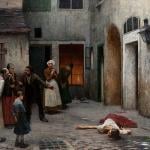Ending with Ralph Ellison’s Juneteenth, for today’s holiday.
Lillian Lee, Farewell My Concubine. I spotted this in a used-book store and grabbed it at once. I’d never realized the 1993 Chen Kaige film was based on a book. And if you loved that lush, heartbreaking movie, let me tell you, the book is very much like it. Farewell tells the story of two men, trained from childhood to perform in the traditional Chinese opera, and the woman who comes between them. Dieyi plays women’s roles and Xiaolou men’s, and this difference plays out in familiar ways in their characterization: Dieyi is vulnerable, brittle, in unrequited love with Xiaolou, wrapping himself in the opera as a flamboyant refuge from reality. Xiaolou is protective and parties and gets married, and loves Dieyi as a brother, you know how they do. Juxian is a determined ex-prostitute, filled with her own longings and resentments but largely existing here as a living symbol of the divide between the men.
The book, like the film, is melodramatic in the extreme and full of glittering surfaces, gilded and iridescent shards of poetry. It’s also at least as political as the film, if not moreso. Farewell switches genres once the Cultural Revolution begins. Before, it had seemed like it was a classic tragedy in which the inherent character flaws of the protagonists and the underlying tensions between them slowly develop and lead to their downfall. Then it seemed like they might be finding a way through–a way to live within the disappointments and losses, to make them not tragic but simply the stage on which people survive and stay together. Politics and war weave in and out of these two narratives in order to illuminate the characters of Dieyi and Xiaolou.
But the Cultural Revolution brings convulsive waves of violent rejection of the past. The opera survives briefly as a forum for propaganda, but soon enough the singers are being paraded down the street with signs around their necks proclaiming their “crimes,” as child soldiers beat and spit on them. The revolution becomes (you’ll be shocked, I know) a pretext for power grabs and dehumanization of “class enemies” like Dieyi and Xiaolou. Everyone’s under pressure to be the most revolutionary person in the room; everyone learns to say things they don’t believe.
And the Revolution weaponizes the tragic elements in the earlier part of the novel. The scene where Dieyi and Xiaolou are forced to denounce one another publicly is harrowing precisely because they end up saying things they know to be true–they reveal the real character defects of people they love. It’s like in Life and Fate when the Soviet interrogators use people’s consciences–their awareness of their real sins–to undermine the self-respect that would have allowed them to resist.
I don’t remember if the movie includes the coda in Hong Kong. If it does, I assume it does not include the painfully prescient foreboding about what will happen when Hong Kong is handed back to the Chinese Communist government. So, you know, Juneteenth isn’t the only book in this post with especial contemporary relevance.
Barbara Hambly, Fever Season: Another historical novel in swooning love with the details and surfaces. The new lucifer matches, the shell-paved roads, the… horrifying 19th-century medical techniques? Yes, lay it on me, I love this stuff. Fever Season is a mystery set during the 1833 yellow fever epidemic in New Orleans. Our amateur detective is Benjamin January/Janvier, born in slavery but now free, who trained as a surgeon in Paris but only able to get work as a musician in Louisiana (newly part of the USA, and boy howdy, that doesn’t help matters). Except for the summers. In the summers the fever comes, and the hospitals suddenly realize that even a black medical man might do them some good.
One night January is accosted by an escaped slave, Cora. He gets mixed up in her plans, but then she disappears–and he realizes that an unsettling number of free black people are vanishing, more than even the deadly fever can explain….
This is the first January novel I’ve read. It’s the second in a series, but I didn’t have any trouble following it. This is also, apparently, one of the two grimmest entries in the series. The horror of life in a slave state is pervasive–even historical details of the kind every reader loves, like the rules of kerchief-tying or the dresses at a ball, are shaped by racism and sexual exploitation and fear. And the book’s climax rises to a level of pure horror which would give Stephen King pause. That climax is taken pretty closely from history, too; you’ll know more or less where it’s going if you already know the name Delphine Lalaurie. (I did know that name, but I didn’t find that knowing it drained the book’s suspense. The suspense comes more from not knowing when and how January will discover what I already assumed was true.) I wouldn’t blame you if you don’t want to read a book which inserts a fictional amateur detective and a made-up mystery into those particular real-life atrocities, but for my part I thought Hambly told a story that illuminated history rather than just exploiting it. The historical mystery is a lurid genre but Fever Season doesn’t make its crimes feel thrilling; I don’t think it appeals to prurient interest.
I loved this novel, although it seems wrong to say you “loved” something which depicts so much real-life cruelty. It’s gripping, the world feels real, January is a vivid character and his blossoming romance with a woman educator is tentative and sweet. I did in fact pick this up because of the ‘rona, and there were some painful parallels: the untrustworthy newspapers; the conflicted medical guidelines, destructive and up for grabs, nobody actually knowing how to beat this thing; the silent streets of the once-busy city. New Orleans’s rich folk went away to their lake houses to escape the epidemic, leaving the poor to sicken, suffer, and die in the streets–or in a hospital that might be worse than the streets. That particular yellow fever struck whites and those with more European blood the hardest. And yet in spite of that, black people were especially at risk because they couldn’t get away; in Hambly’s novel they’re at risk from the fever, and from all the manmade terrors the fever conceals and unleashes. We’re used to thinking of “high-risk” as a biological category: I’m high-risk if I catch the ‘rona because I have preexisting lung damage. But “high-risk” is also–maybe even primarily–a socioeconomic category: I’m low-risk because I have the money to self-isolate and I work from home.
So this isn’t really an escapist novel, is what I’m saying….
Ralph Ellison, Juneteenth: Left not-quite-finished at Ellison’s death, this stream-of-consciousness novel tells the story of Hickman, a jazzman-turned-preacher known as “God’s Trombone,” and the white or white-passing boy he unofficially adopts and raises as his protege. The boy Bliss grows up to reject the black community which sheltered him. When we first meet him he’s a racist politician–who’s about to be shot to pieces by a black would-be assassin. Most of the novel takes place in memory, as Hickman sits by the hospital bed where Bliss drifts in and out of consciousness.
I admit that this novel didn’t harrow me the way Invisible Man did. The stream of consciousness seemed too often willfully obscure; the “America as movieland of distorted flickering dreams, Hollywood as synecdoche” aspect, which I usually love, didn’t get a thorough enough exploration for it to hit hard. It seemed like we were supposed to take Bliss’s speeches seriously and yet I couldn’t wring concrete meaning from any one of them with both hands.
And yet…. What’s good here is extraordinary. The birth and adoption scene is an unforgettable portrait of rage and duty. Hickman comes up with a trick (he’s a bit of a huckster as well as a sincere Christian and the novel’s moral center) of sticking Bliss in a child-sized coffin, taking him to tent revivals and having him rise up from the dead in front of all the sinners to proclaim the Resurrection. This experience traumatizes Bliss; it’s a symbolic death for him and also just a frightening, repeated experience of being trapped in a small dark space. It’s his part in the suffering on the slave ships, his baptism into death so that he can be resurrected as a white-skinned black American, and he really, really hates it. And Hickman judges him as grasping, wanting to be rewarded for his suffering or for his performance of a duty. Everything about this idea works, I think. The image itself, the coffined child. The child’s fear and pleading for treats to make up for his fear. The adult’s inability to sympathize. Why should you get paid for sharing in our death-into-life?
There are hints that Hickman tried to do the work of God here. God, Hickman’s own narration suggests, made Abraham Lincoln into a true man, by making him willing to take on his duties of liberation and suffering. (This Lincoln passage is another of the book’s high points, and one of the only convincing examples of American patriotism I’ve found in our literature.) Hickman tries to engineer Bliss into a kind of second Lincoln–and gets a second George Wallace for his trouble. And yet without someone who is willing to go down into the coffin, to share the “social death” of slavery and rise from it into solidarity with black Christianity… how can there be any reconciliation? How can the country hold together?
And this is, I think, the ultimate dream of Hickman and also of Ellison–and maybe, somewhere under the bandages, under the lies and fear, under the hatred and self-hatred, the dream of Bliss: that we can die together to rise together. That we are still bound together home.











